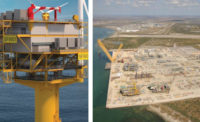In an economy flush with capital and a growing need to replace aging infrastructure, the construction industry is witnessing record growth in megaprojects as well as a cultural shift in how those projects are managed.
The annual value of megaproject starts in the U.S. has risen to nearly 33% of total starts in 2018, from 3% of total starts in 2013, according to an April 2019 North American Megaprojects study by FMI Corp. Since 2012, at least 320 megaprojects have been awarded in the U.S., representing $718 billion in investment, with another 674 megaprojects—representing $2 trillion in investment—still in planning. Significantly, the average size of a megaproject in the U.S. is expected to rise 37%, to $2.9 billion from $2.1 billion, the FMI study notes, comparing awarded projects between 2012 and 2018 with those forecast between 2019 and 2023.
Part of the reason owners have decided to package multiple building and infrastructure projects “as one megaproject versus in phases, is because the market is so hot,” says Ron Magnus, founding principal, FMI Corp. In addition, he says construction companies are getting larger, making it easier for them to handle bigger projects. “In the ’90s, we had a handful of companies that were a billion dollars in size—including Bechtel, Fluor and Turner,” Magnus says. Today, there are at least 100 companies worth more than $1 billion, and that number will double in five to seven years, he predicts.
The need to replace aging infrastructure is a leading driver of megaprojects. “U.S. industrial and infrastructure segments have increasingly embraced megaprojects as a means for expansion,” FMI says. In 2018, industrial and infrastructure megaproject starts represented the majority, or 61%, of spending on all projects in those sectors, up from 42% of starts in 2017, and only 1% five years earlier, FMI notes.
The study estimates U.S. infrastructure construction put in place (CPiP) from now until 2030 to be in the range of $4.5 trillion. “There’s a huge recognition in the U.S. that infrastructure is crumbling, whether it’s water, roads or bridges,” Magnus says.
Overall, annual megaproject CPiP is expected to rise 460% during the next five years, growing to just over $295 billion from $53 billion, the FMI study notes. Over the next decade, annual spending on megaprojects is expected to increase nearly 600%, to just over $350 billion.
Most of the planned megaproject spending is expected to occur in the South and the West, at 37% and 30%, respectively, according to FMI. The top three states, representing 40% of the total, are New York and California, each at 15%, and Texas at 10%.
While owners are starting to recognize the efficiencies they can achieve with megaprojects, “they’re struggling just like contractors and builders and engineers to find the right people to scale up to do what’s never been done before,” Magnus says. “When you are working in the millions of dollars, the magnitude of a mistake is huge.”
Effective Leadership & Transparency
Until 2010, the University of California San Diego’s largest project was a $227-million cardiovascular center. Seven years later, it had completed a $972-million medical center and now has a large building program underway, with plans to spend $10 billion in the next eight to 10 years. Currently, it is constructing a $626-million multibuilding educational and residential community, and was recently awarded a similar $640-million project, in addition to beginning schematics for a $450-million campus headquarters. It is also planning a $500-million to $1-billion replacement hospital at UCSD Medical Center’s Hillcrest campus in San Diego.
“The successful megaproject teams must have a strong project culture, strong project leadership and excellent execution,” says UCSD Associate Vice Chancellor Eric Smith, who serves on a leadership team for Capital Program Management with Randy Leopold, the university’s senior director of health care project management. The team seeks better ways to lead megaprojects.
“The scale of a megaproject puts a premium on leadership at all levels.”
– Carlos Crabtree, Project Executive, DPR Construction
Traditional project cultures can be based on staying mum, with owners often communicating a “culture of suppression,” Leopold says. “They don’t want to hear any bad news.” Today, UCSD wants to take the opposite approach—achieving full transparency. “We’re actually out there promoting the uncover,” Leopold says. That requires a willingness to be vulnerable—“to be willing to admit when you need help,” he says.
Achieving transparency from the start is a key best practice for megaprojects, says Danielle Simpson, associate vice president at CallisonRTKL. She is working on the concept for the initial $400-million phase of the $1.5-billion Hillcrest campus redevelopment, including an outpatient pavilion. Simpson recommends estimating specifically what’s included in the budget and what’s excluded “so you know the parameters you’ve set and are able to have an open dialogue … to avoid building expectations based on the perfect scenario that never, never works,” she says.
When contract costs are unknown because of a lack of transparency, this can lead to aggressive bidding with “extremely tight budgets that don’t allow any flexibility for unforeseen changes … no room to adjust over the course of the project,” she says.
“The scale of a megaproject puts a premium on leadership at all levels,” says Carlos Crabtree, DPR Construction project executive. DPR has found that investing in high-performance teaming during preconstruction allows key stakeholders—including the owner, design team, contractor and key subs—to develop a project charter for alignment on mission, vision, core values and metrics, he says. Teaming developed at the cardiovascular center project allowed for a major programmatic change midway through construction and avoided a major materials defect, Crabtree says.
Timely decisions from project managers are also critical for megaproject success. “Whoever’s in charge needs to have delegated authority to make quick decisions,” says Larry Warner, a former Colorado Dept. of Transportation director who oversaw Denver’s $1.7-billion, five-year T-REX project. Completed in 2006, it reconstructed 17 miles of interstate while adding 19 miles of light rail. Warner recalls having the authority to make decisions on a $17-million change order to replace two I-25 bridges. “Our project contingency and savings allowed us to add those two critical overpass bridges … and stay within the $1.7-billion budget … a win-win for all,” he says.









Post a comment to this article
Report Abusive Comment